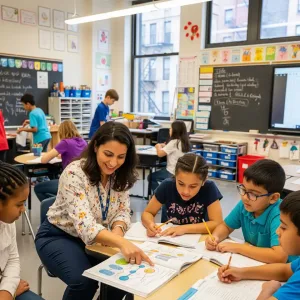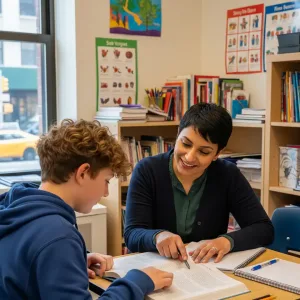What Are Push-In Services?
Push-in Special Education Teacher Support Services (SETSS) occur when a licensed special education teacher provides instruction within the general education classroom. Instead of being pulled out, the student remains with peers while receiving individualized support.
When Do Push-In Services Work Best?

Push-in services are especially effective when:
- A student can follow the general curriculum with targeted assistance.
- Collaboration between the classroom teacher and SETSS provider enhances instruction.
- Social inclusion and peer modeling are important for the child’s development.
Who Receives Push-In Support?
Students with Individualized Education Programs (IEPs) who need extra help but can succeed in a general education classroom often receive push-in services. Common areas of focus include reading comprehension, organization, and classroom participation.
Benefits of Push-In Services
- Inclusion: The child learns alongside peers in a natural classroom setting.
- Collaboration: Teachers coordinate strategies for consistency.
- Confidence: Students avoid stigma by staying in class.
- Practical Application: Skills are reinforced immediately during lessons.
Limitations of Push-In Services
- Less individualized attention compared to small pull-out groups.
- Classroom distractions may interfere with instruction.
- Teachers must manage roles carefully to avoid overlap or confusion.
How Push-In Supports Overall Learning
Push-in services allow students to access the general curriculum while still receiving specialized support. They promote inclusion, confidence, and independence, helping students thrive without isolating them from peers.
What Are Pull-Out Services?
Pull-out Special Education Teacher Support Services (SETSS) take place when a student leaves the general education classroom to work in a smaller group or one-on-one with a special education teacher. This environment provides targeted instruction away from classroom distractions.
When Do Pull-Out Services Work Best?

Pull-out services are most effective when:
- A student requires focused attention to learn specific skills.
- The general classroom environment is too overwhelming.
- Intensive instruction is needed to catch up in reading, writing, or math.
Who Receives Pull-Out Support?
Students with IEPs who need direct, specialized instruction that cannot be fully provided in the classroom benefit most from pull-out services.
Benefits of Pull-Out Services
- Personalized Instruction: Tailored to the child’s unique learning style.
- Reduced Distractions: Small settings allow for better focus.
- Skill-Building: Ideal for teaching foundational skills.
- Confidence Growth: Students can practice without pressure from peers.
Limitations of Pull-Out Services
- Students may miss portions of classroom instruction.
- Can create a sense of separation from peers.
- Requires careful coordination to prevent gaps in learning.
How Pull-Out Supports Overall Learning
Pull-out services provide the intensive, individualized support some students need to make progress. When combined with push-in support, they ensure that children receive the right balance of inclusion and targeted intervention.
Together, push-in and pull-out services complement each other. One keeps the student engaged in the classroom while the other provides focused support. The right mix depends on your child’s needs, as outlined in their IEP.

